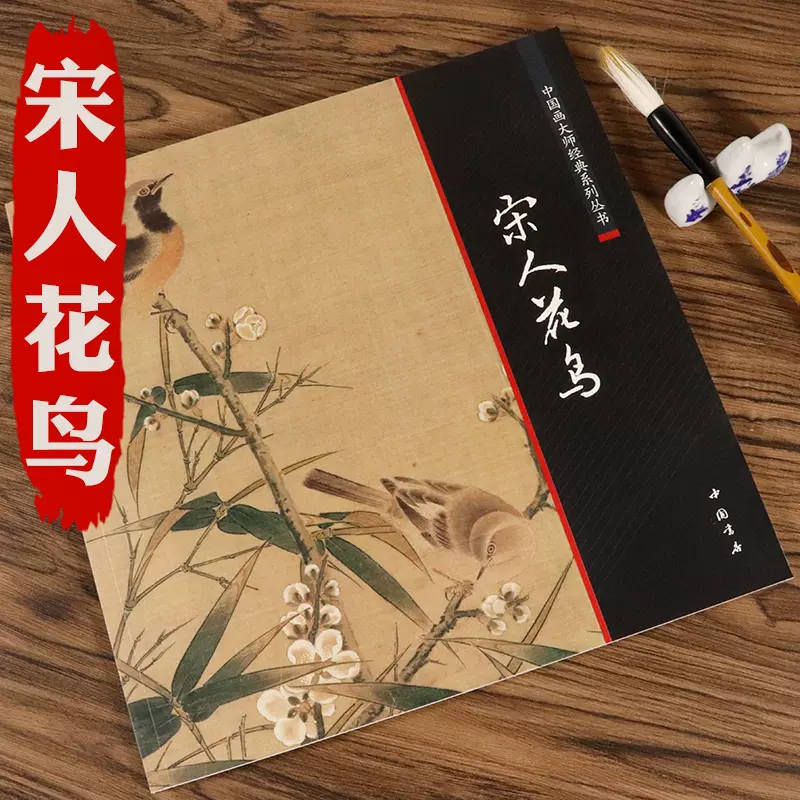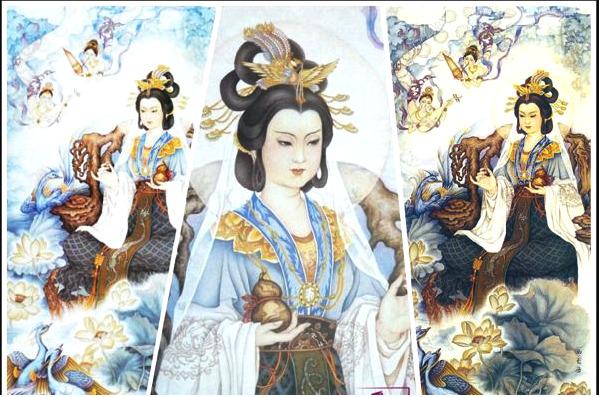
The realistic spirit of flower-and-bird paintings in the Song Dynasty
Traditional Chinese paintings can be roughly divided into three categories: figures, landscapes, and flowers and birds. Figure painting started early. During the Qin and Han Dynasties, tomb murals, silk paintings and works on portrait bricks had reached a certain level. By the Wei, Jin, Southern and Northern Dynasties, figure painting gradually became complete; landscapes were initially the background of figure painting, as an independent subject of painting. , appeared in the Sui Dynasty and matured in the Tang Dynasty; as for the theme of flowers and birds, at the beginning, it was just a decoration for figure paintings. As an independent painting discipline, it developed in the Sui and Tang Dynasties and reached its peak in the Five Dynasties and Song Dynasty. The three subjects of painting are not only different in subject matter, but also show obvious differences in techniques. For example, figures emphasize lines, landscapes emphasize pen and ink, and flowers and birds prefer colors. Among the traditional landscape, figure and flower-and-bird paintings, I think the flower-and-bird paintings of the Song Dynasty have the most realistic qualities.
Flower and bird paintings, from the Five Dynasties to the Song Dynasty, are meticulous in coloring and depicting nature. Their level of realism can still be seen one by one with the natural scenery around them. This kind of painting tradition is worthy of our continuous study and reference.
Look for birds in Song paintings:

Sketch of Rare Birds (Chinese Painting·Detail) Zhao Ji (Northern Song Dynasty)

Little Peacebird Photo by Qian Bin

Apricot Blossoms and Spring Birds (Chinese Painting) Lin Chun (Southern Song Dynasty)

Sketch of Rare Birds (Chinese Painting) Huang Quan (Five Dynasties)

White Wagtail (gray-backed eye-striped subspecies) Photo by Chen Shuihua

Embroidered Feathers Singing in Spring (Chinese Painting) Anonymous (Song Dynasty)
Respecting the museum tradition of the past
How realistic the paintings of the Song Dynasty were, seems to be a secret buried by time. The “Complete Collection of Song Paintings” in the “Chinese Painting Department of Ancient Dynasties” cultural project co-hosted by Zhejiang University and the Zhejiang Provincial Cultural Relics Bureau helped open a window for my research. “The Complete Collection of Song Paintings” currently contains more than 1,000 paintings of the Song Dynasty. Starting from the theme of birds, I selected 171 works with bird images, plus 3 works that were not included in “The Complete Collection of Song Paintings” but were considered credible. The paintings were statistically analyzed and compiled into a book – “Both Form and Theory: Birds in Song Paintings”. From the perspective of the theme of birds, this book reproduces the tradition of famous things, natural history and investigation of things in the Song Dynasty, and reinterprets the common painting theories such as “sketching from life”, “freehand brushwork” and “form theory”.
Take Huang Quan’s “Sketch of Rare Birds” as an example. Huang Quan was a famous flower-and-bird painter in the Western Shu period of the Five Dynasties. The flower-and-bird paintings of him and his descendants were mainly meticulous and realistic, with gorgeous colors. He was known as the “Huang Family’s Wealth”. This painting style was the mainstream of flower-and-bird paintings in the Song Dynasty. . “Sketch of Rare Birds” is ink and color on silk, measuring 70.8 cm in width and 41.5 cm in height. There are 24 animals painted evenly throughout the painting, including 10 birds, 2 turtles, and 12 insects. All the animals in the painting can correspond to specific species in reality. It is conceivable that when Huang Quan was painting, he was indeed sketching based on reality, because according to records, no artist had painted like this before, or had painted these animals. The depictions of these 24 animals are not only realistic in shape, but also the size proportions basically refer to the actual size of the species. Among them, 9 species of birds are common wild birds near Chengdu, Xishu. Among them, sparrows, white-headed bulbuls, white wagtails, great tits and northern redstarts are the most common birds not only in Sichuan but also in the entire southern China. They are more common in cities and suburbs. Gray starlings, mercerized starlings, and white-rumped munias are more common in suburban wilderness areas. It’s no surprise that they appear in Huang Quan’s writing. I believe that Huang Quan, who lived in the palace, should have had many opportunities to observe them, or capture them through his servants for sketching.
Among the 174 Song Dynasty paintings I studied, most of them are flower and bird paintings, including a few small landscapes and figure paintings containing bird images. Specific species can be identified in 88% of them, which is far higher than mine. Anticipate. The bird images among them can be roughly divided into four categories: identifiable in fine brushwork (68%), unidentifiable in fine brushwork (2%), identifiable in simple brushwork (20%), and unidentifiable in simple brushwork (10%). There are 67 species of birds in total. It can be seen from this that the flower and bird painters of the Song Dynasty, represented by Huang Quan, not only painted familiar birds around them, but also recorded a large number of birds that accidentally broke into the field of vision, including hunting and observing birds.
By systematically analyzing and sorting out the flower-and-bird paintings of the Song Dynasty, we will find that in fact, in the Song Dynasty of my country, there was already a natural history tradition in the modern sense. Although those Song Dynasty painters did not necessarily know every bird they painted, nor did they necessarily name every bird, these paintings fully demonstrate that they understood and were able to distinguish the morphological characteristics, behavior and ecological habits of different birds. , this is the embodiment of our country’s tradition of studying things to understand the truth and seeking knowledge, and it has the same goal as Western natural history.
Understand Song paintings from birds:
Reproduce the artistic spirit of sketching
The presence of a large number of strange and accidental birds in Song paintings shows that the flower-and-bird painters of the Song Dynasty directly drew materials from the wild when creating, which is what we usually call “sketching”. This also shows that sketching is not a tradition of Western art, but an early tradition of Chinese painting. Not only are there a large number of works named “Sketching from Life” in “The Complete Works of Paintings of the Song Dynasty”: sketches of rare birds, sketches of butterflies, sketches of grass and insects, sketches of gardenias, sketches of crape myrtle… there are also many discussions of “sketch from life” in treatises on the history of painting. However, because the tools are not easy to carry and use in the field, the history and theory of painting have always been unclear about how traditional Chinese sketching is carried out, and there is a lack of empirical evidence.
In the anonymous “Embroidered Feathers Singing in Spring” collected in the Palace Museum, the author left us evidence of sketches of flowers and birds from the Song Dynasty: the white wagtail in the painting has an extra thin line on its feet. This should be the real situation that the artist faced when he created this painting: there is a white wagtail being led by a thin thread and tied to a lake stone, so that the artist can use it to describe life. This thin thread left by the painter intentionally or unintentionally answers our confusion: the painters of the Song Dynasty probably captured these birds alive, and then tied them with a thin thread to their habitat, or to the ground or branches. Let it jump and use it for observation, so that both form and spirit are taken into consideration.
Whether it is fine brushwork or freehand brushwork, imitating nature and approaching reality is a common pursuit of flower-and-bird paintings in the Song Dynasty.
Sketching seeks to resemble the form, and freehand brushwork seeks to express the spirit. If a painting of flowers and birds can achieve both form and spirit, it should be considered a top-quality work. But the pursuit of painters in the Song Dynasty went beyond this. There was also the word “reason” in their hearts.
Su Shi said in “Jingyinyuan Painting Notes”: “I have tried to comment on paintings, and I think that people, birds, palaces, and utensils all have constant shapes. As for mountains, rocks, bamboos, wood, water ripples, smoke and clouds, although they have no constant shapes, they have common principles. … The loss of regular shapes , stop at what is lost, but cannot cure it completely. If the common sense is inappropriate, it will be abandoned.” Wen Tong further said: “You can’t lose the shape, but the principle should be understood, life and death, old and new, smoke and clouds, wind and rain. , must be true to form, conform to the creation of heaven, be disgusted with human will, and have both form and theory, and then we can express Xiaohua.” What exactly is the “principle” emphasized by Su Shi and Wen Tong, so for “Xiaohua” and creation. important? In this regard, the common explanation is that the “reason” referred to by Su Shi and Wen Tong is related to the rise and prevalence of agentism in the Song Dynasty. This theory believes that there must be a “reason” behind everything. The “reason” in it is close to what we usually understand as “principle”, “principle”, or “objective law”. So, in what aspects of flower-and-bird painting are the principles of painting specifically reflected, and how did the painters of the Song Dynasty pay attention to it?
Through research, it is found that the spirit of respecting objective laws is reflected in the creative details of the flower and bird painters of the Song Dynasty. First of all, different birds have their own specific living environments. Secondly, the relationship between birds and seasons is also worth paying attention to. We don’t see all the birds in one season because a large proportion of them are migratory. Plants and flowers have more obvious seasonality, and the correspondence between plants, birds and seasons is the most easily overlooked aspect of painting. Thirdly, the relationship between birds and food also deserves special attention. Different birds hunt or forage different foods. Finally, the behavior, posture, etc. of birds cannot be ignored.
Take Li Di’s “Snowy Trees and Cold Birds” collected by the Shanghai Museum as an example. Li Di, a court painter of the Southern Song Dynasty, painted a wedge-tailed shrike standing on a thorny branch with all its leaves shed in winter. For Lin’an, the capital of the Southern Song Dynasty, the wedge-tailed shrike is a winter migratory bird that mainly inhabits rural wilderness areas and mostly moves alone. It is common to see it standing on the branches waiting for prey. Shrikes have a special habit of piercing thorns or twigs with the small animals they hunt. Therefore, shrikes often appear in paintings together with thorn branches. Li Di’s paintings are not only realistic in form and expressive in posture, but also strictly follow the principles of painting in terms of the relationship between birds and seasons, environment, and food, as well as in terms of bird habitat and behavior. Systematically combing through the existing flower-and-bird paintings of the Song Dynasty, we will find that works similar to “Snowy Trees and Cold Birds” abound. It can be seen that “having both form and theory” is the common pursuit of painters in the Song Dynasty, even the highest pursuit.
Today we are talking about the inheritance of Song Dynasty paintings. What needs to be emphasized is the inheritance of the style, skills and spirit of Song paintings by later generations of painters, as well as the inheritance of Song painting methods. Whether it is sketching and copying, or freehand brushwork, Song Dynasty flower and bird paintings have great influence on regulations. The grasp and pursuit of form and theory are worthy of reference by contemporary creators.

Author: Chen Shuihua, director of Zhejiang Provincial Museum and PhD in ornithology from Beijing Normal University
Source: Guangming Daily 2024-04-21

